To begin with, if we are going to have singing at all, we must have the most beautiful possible singing, and it is not more natural to sing badly than to sing well.
Jean François La Harpe, Journal de Politique et de la Littérature October 5, 1777
Assumption: Voice teachers want their students to sing beautifully.
Questions: What is Beautiful? How is this Beauty Achieved?
Whether beauty is a matter of taste, technique, or aesthetics, the fact remains that the way in which the performer strives towards the ever elusive Beautiful is something that must be taught; and what must be taught is not simply an appreciation or recognition of beauty, but the physical process by which it might be achieved. Many singers and instructors believe that beautiful singing represents the culmination of technical mastery and one could hardly argue with the notion that bel canto goes beyond the way one sounds, to include the manner in which one achieves that sound. Technical mastery alone, however, is not beauty. The "problem," as suggested in the title of this paper, is not that clear and strong vocal tones are undesirable, but rather the tendency to conflate technical mastery alone with beautiful singing. Truly beautiful singing can only be achieved through the pairing of technical mastery with an internalized understanding of both poetic and musical events; it is the confluence of these three elements—technique, poetic awareness, and musical understanding—that constitutes the complete interpretation of a song. In maneuvering through the many technical challenges manifest in a particular work, students should be asking questions such as: How might the technical challenges inherent in a work inform its meaning (and vice versa)? How might this feed into an interpretation of the work?
Many of history's great vocal pedagogues demanded a step-by step approach to singing in which a singer would first be trained in music on a general level, then would study only vocalizes for some time before advancing to an actual song (and any interpretation thereof). The famous pedagogue, Giovanni Lamperti (1839-1910), believed that any voice could sound "agreeable," if trained in proper technique. On the other hand, "those students who lack the patience to sing exercises exclusively for a few months will never become singers."1 Elizabeth Schumann's (1888-1952) teaching reflected this as well.
Generally a long time passed before [Schumann] allowed a pupil to venture upon text. The stage must be reached when he could profit technically from experimenting upon text, and this stage is considerably more advanced than most students seem to think. If the attempt is made too early, all the good work done in the exercises is steadily undone by each song or aria attempted, and any effort at interpretation is utterly without avail.2
Mathilde Marchesi (1821-1913) also advised that a complete mastery of the voice be achieved before attempting to sing any songs or arias:
When all mechanical difficulties have been overcome, from the formation of the tone up to pronunciation, the pupil may pass on to the study of the Air and Recitative, and so enter upon the aesthetics of the art of singing without being arrested every moment by vocal or musical faults, or by a badly pronounced word or syllable. Pupils can now give their attention exclusively to the sentiment and expression, and commence to acquire a knowledge of the different styles found in the many kinds of vocal music.3
Unfortunately, the demands of the typical four-year college music degree are not easily reconciled with the older pedagogies and students do not have the luxury of slowly building their voices before embarking upon techniques of expression and interpretation.
According to current practice, voice instructors assign music that the student will perform before a jury of voice faculty at the end of each semester. This music is not only to be within the physical capabilities of the student, but should be deemed to be high quality; after all, student and instructor alike will spend several months with these songs. The songs are also typically drawn from the standard vocal canon; this is particularly important in music curricula that lack a vocal literature class, as the voice lesson may be the only chance for the student to learn standard vocal repertoire.
The typical curriculum assigns the student between five and nine songs and/or arias per semester and, because students and teachers do not have several months to focus on vocalizes, the instructor uses the songs/arias as a means to teach vocal technique. The crafty teacher will assign works whose technical challenges reflect the skills that a student is trying to learn. Brahms's "Wie melodien zeiht es mir" might be assigned to the student who is working on long phrases and breath control; Duparc's "Extase" might be given to the advanced student who is working on mezza voce, and so forth. Missing from most curricula, however, is anything more than a cursory discussion of the larger issues of interpretation, and most consideration of musical structure, style, and academic understanding is left in the classroom next door.
Most accomplished musicians would agree that truly "beautiful" singing requires rigorous study and analysis of all aspects of the music and text. Indeed, some of the best performers of Schubert reflect their study through an emphasis of character and collaboration, sometimes to the detriment of technically precise tone production. Consider the famous collaborations between Pears and Britten on the Schubert song cycles. Few would say that Pears achieves the finest tone quality, but the character of the performances makes them instantly recognizable as unique. Even the original pianist/singer duet of Franz Schubert and Michael Vogl was said to emphasize interpretation and collaboration more than the beauty of their sound.4
Unfortunately, the sheer amount of repertoire to be learned and the traditional disconnect between applied lessons and courses such as history and theory often preclude this labor-intensive approach to a single work. In addition, most aural-skills and music-theory curricula avoid standard voice repertoire until students are in their final semesters of theory study, if they ever include it at all.5 Meanwhile, in the voice studio, the song may be treated primarily as an exercise through which the student learns some aspect of vocal technique, while largely ignoring the music and the poetry.
In order for their students to achieve beautiful singing, voice teachers must carefully balance the consideration of technical and interpretive skills, as well as the acquisition of repertoire in their lessons. In this essay, the authors propose a possible pedagogical approach in which issues of vocal technique, musical analysis, and poetical analysis may each be discussed in a way that reinforces the others. The proposed method starts by identifying the technical challenges manifest in a single work and uses these as a doorway into musical and poetic interpretation. The latter then informs the former, with the result that the technical challenges might be overcome while a bona-fide interpretation of the work is achieved. Indeed, following on the footsteps of Pears and Vogl, a full understanding of the poem, the music, and the possible meanings within them can lead to clearer, more purposeful, and, hence, more effective technique.
In order to demonstrate the possibilities manifest in the expansion of the traditional "technical" approach, this article presents two examples from Schubert's Die schöne Mllerin, both of which often find themselves in the hands of an undergraduate vocalist. The songs are vastly different in construction, scope, and tone and each contains a myriad of vocal challenges. Lightly annotated scores for each song will precede their discussion.
The first song of the cycle is short, strophic, and has a folk-like melody that is relatively easy to learn. Some of the technical challenges that a teacher could focus on are:
1. Leaps and Legato. In the opening phrase the singer is presented with a surprisingly disjunct melody that requires a successful negotiation of the intervals as well as the technical challenge of quickly flipping from one vocal register to another and back, all to be done while still singing legato. The ability to sing legato (and flexibly) is also made difficult by unnatural text accentuations.
2. Flexibility. The second measure of the vocal part includes arpeggiated sixteenth notes in a relatively difficult portion of the young singer's range.
3. Long phrases, some of unusual length. The third phrase is twice the length of the first and second. One can put a breath in the middle, but continuing the phrase here (in tempo) is difficult.
4. Quick breaths. Several spots within the vocal line call for breaths, but in several cases, there is no more than an eighth note in which to take a breath.
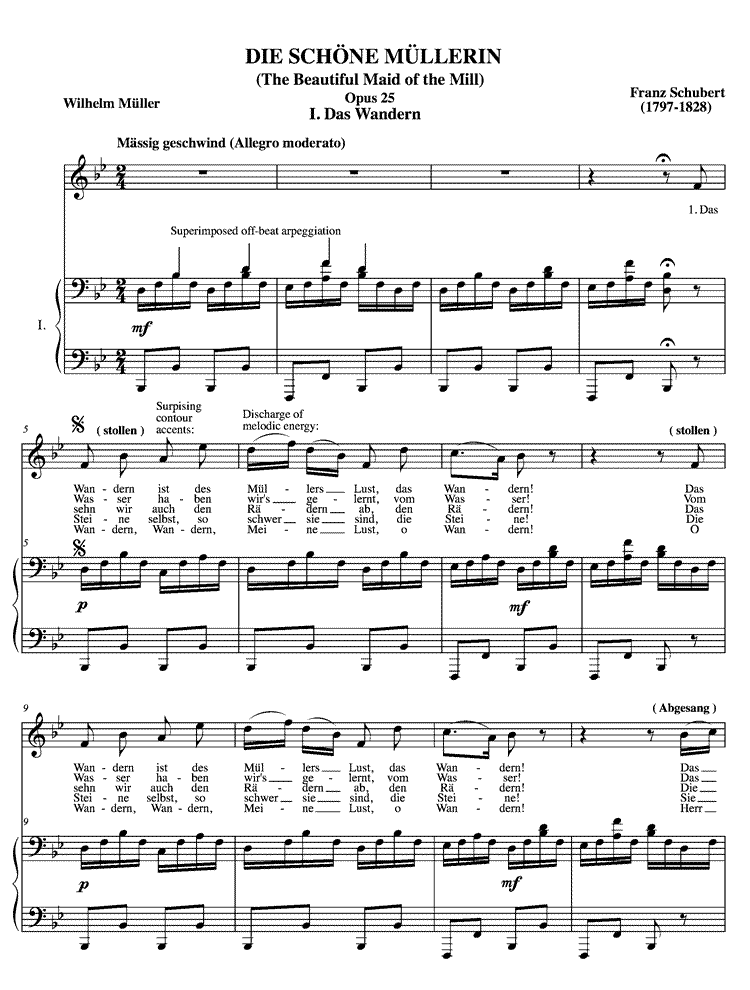
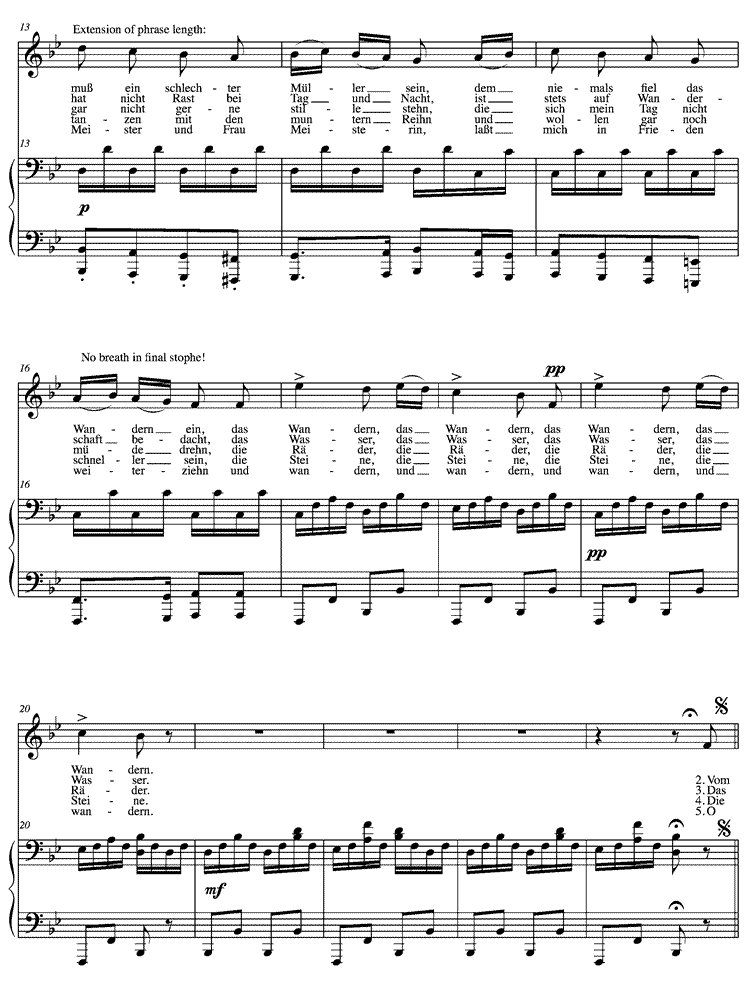
|
Das Wandern |
Wandering |
|
Das Wandern ist des Müllers Lust, |
Wandering is the miller's joy, |
To approach the song as a purely technical exercise would certainly support the development of useful skills and healthy singing. However, this list, while not comprehensive, can also provide an entryway into the interpretation of the song, leading to a fuller understanding of the work and, ultimately, better performance. If students can understand why these musical challenges might exist in the song then they may be able to sing them more successfully.
As the opening song in the cycle, "Das Wandern" plays an essential role in introducing the primary characters while setting the stage for the unfolding drama. Each of the technical challenges listed above plays a role in characterizing the primary protagonist of the cycle, the miller, who sings emphatically, perhaps overly so, of the joys of wandering. He is not referring to aimless walking, of course, but a Romantic-era pastoral cliché that suggests the following of a winding road or, in this case, a river through the countryside, while never being tied to a fixed location for long. The idea of "wandering" permeates the cycle, for although the miller halts briefly in songs three through five, the remainder of the cycle concerns itself with a winding psychological journey through rapidly changing emotions. Indeed, it is only in his merger with the winding river in the final song of the cycle that the miller is finally able to assuage his compulsion to wander. The singer should begin to recognize how this somewhat capricious wandering manifests itself within the song (and, ultimately, in the cycle) and in so doing will likely discover that many of the technical challenges arise from Schubert's careful adherence to the poetic narrative.
The notion of constant wandering is revealed musically throughout the song in terms of the previously mentioned disjunctions, surprising changes of patterns, atypical accentuations, asymmetrical phase subdivisions, and a pulsing bass line that suggests footsteps through its binary rhythmic division of the beat. The music supports a sense of frequent displacement, relating metaphorically to the text. The piano plays as much a role in this as the singer and ultimately, the piano's introduction prepares the singer's opening line, while providing a succinct reminder of the miller's character. The piano begins with arpeggiations that emphasize the third 16th note of the beat through contour and a superimposed augmentation of the arpeggiated figure (B♭-D-F-D-B♭-D-F-B♭), elements of which fall on the fourth and eighth beat of the introduction.
The singer's line follows suit, with contour accents arriving on the tonic and the (typically unaccented) seventh over the dominant, and appearing on the off-beats of mm. 5 and 9. The singer must contradict a natural tendency to emphasize the wrong syllable ("das Wan-DERN ist DES") and instead realize that the discharge of melodic energy begins on the word "Müller," the point at which the melody's embellished arpeggiation reaches scale-degree 3. The melodic discharge takes the explosive form of the 16th note melismas in the high part of the singer's range, not only requiring vocal flexibility but also the ability to carry the phrase through the pitches of the arpeggio to end on the essential word "Lust," or joy (to be sung: "das WAN-dern ist der MÜL-ler's LUST").
It is not enough simply to recognize that syllabic emphasis and unusual accentuation is an issue to be discussed from a technical perspective. Rather, the student or instructor might ask: What musical/poetic purpose might we attribute to these moments? Indeed, students may benefit from an awareness that Schubert reserves these measures in the strophic design for important text (our translation is provided). It is here that the listener is introduced to the brook in its role as teacher, the circularity of the mill wheels (and, incidentally, of the songs), and the heaviness of the mill stones (later to be associated with the miller's own heart). The circular motion of these mill elements and the burbling of the river are all suggested in the piano's arpeggiations and the encircling of pitches in the voice (A-E♭-D in mm. 5-6; D-F-D in m. 6; C-A-B♭ in m. 7). Thus, the challenges present here serve to highlight an essential point in the musical and poetic texts, while pointing toward broader text-music relationships.
The discomfort that young singers might have with this passage's displaced accentuations and sixteenth-note discharge may be enhanced by its asymmetrical phrasing: an in-itial unit that lasts two full measures ("das Wandern ist des Mülllers Lust"), and a second ("das Wandern" in m. 7) that lasts only one. A regularity of phrasing is maintained only by the piano, which returns to the dual-layered arpeggiations of the introduction, completing each of the initial two 4-bar units. Thus, Schubert maintains the sheen of a folk-song inspired bar-form (Stollen-Stollen-Abgesang, or AAB), while creating disturbances in its internal symmetry. The singer, like the miller, cannot lean on the piano's pastoral cliché, but instead might push forward toward the end of this overly long phrase in what, at least by the second or third repetition, begins to seem like over-exuberance. The Abgesang is dramatically different from the initial two phrases with its completely stepwise motion and the addition of dissonant diminutions. In addition, it provides little in the way of opportunities for breaths. The piano's Bb pedal moves from the left-hand eighths of the first half to right-hand sixteenths in the second. The consistency of the "wandering" is maintained, but perhaps the exuberance of the Stollen has the potential to become urgency here. Indeed, the voice moves largely in parallel tenths with the winding bass, foreshadowing the miller's close adherence to the river's path.
The final strophe of the text may be the most significant here, as it supports a reading of growing urgency, while providing the first true indication of the miller's origins, "Herr Meister und Frau Meisterin, laßt mich in Frieden weiterziehn und Wandern" (Oh, Master and Mistress, let me push on in peace and wander). This verse is different from the previous four in that it does not include a comma before the final two words. In each of the previous verses, the young singer will undoubtedly want to take a large breath at this comma ("Das Wandern;" "Die Steine;". . . "Und wandern"). While the conjunction "und" and lack of a comma provides an opportunity for the singer to differentiate the fifth verse from the others, it is quite technically difficulty, especially for the singer with less developed breath control. In order to preserve the integrity of this sentence, the singer must now sing a phrase that consists of twelve beats. The singer might choose to highlight the final lines for the audience, mirroring the miller's "pushing onward" with a slight increase of energy and tempo. In any event, the difficulty the singer has in finding a breath in the second half of the song supports the breathless enthusiasm of the character, whose (again) overemphatic leaps to the seventh over the dominant (mm. 16-19) suggest that something may already be amiss. Any time taken at this point to get a longer breath might improve tone quality, but would contradict the very effective musical characterization of the miller.
The unmodified strophic form of Das Wandern certainly presents its own challenges. Distinguishing the verses for the audience requires careful consideration of the poem, and is difficult to achieve without an understanding of Schubert's miller. Each of the technical challenges enumerated above (and the many challenges not discussed in the present context) plays a role in this musical characterization.
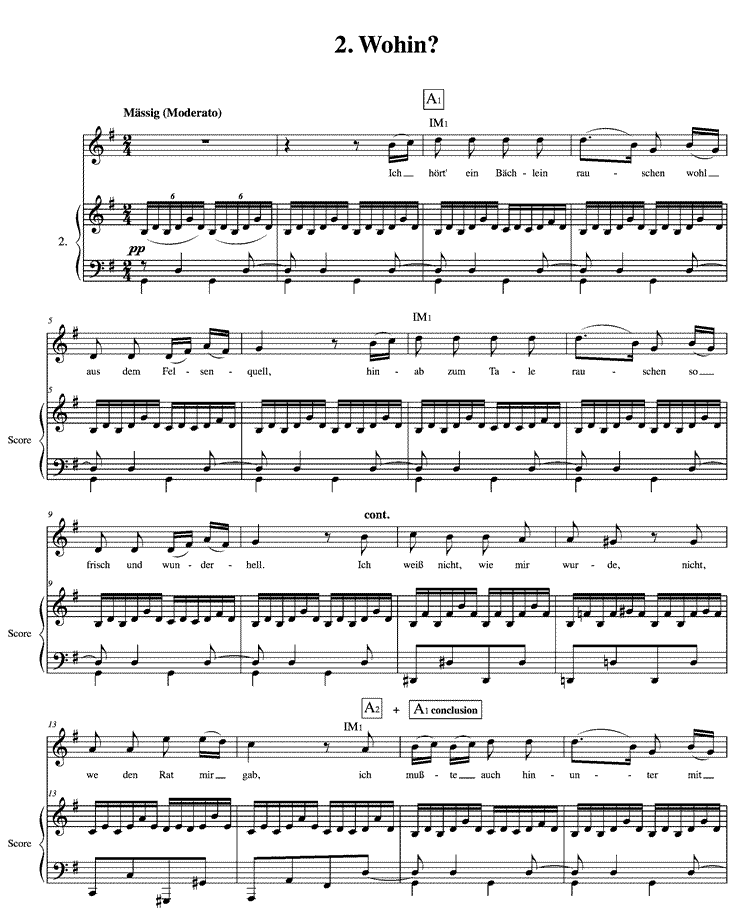
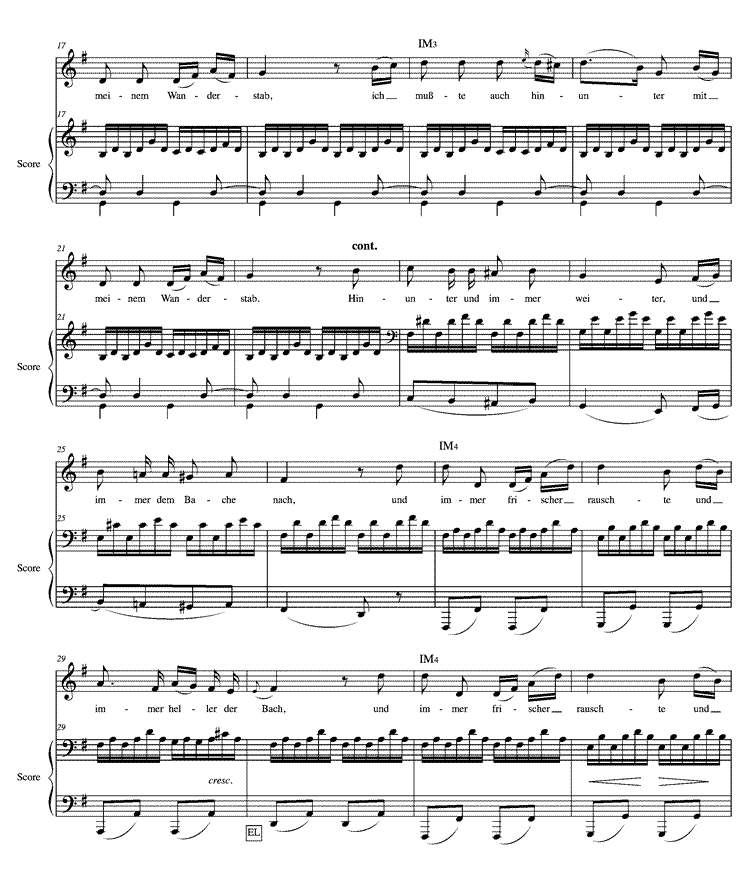
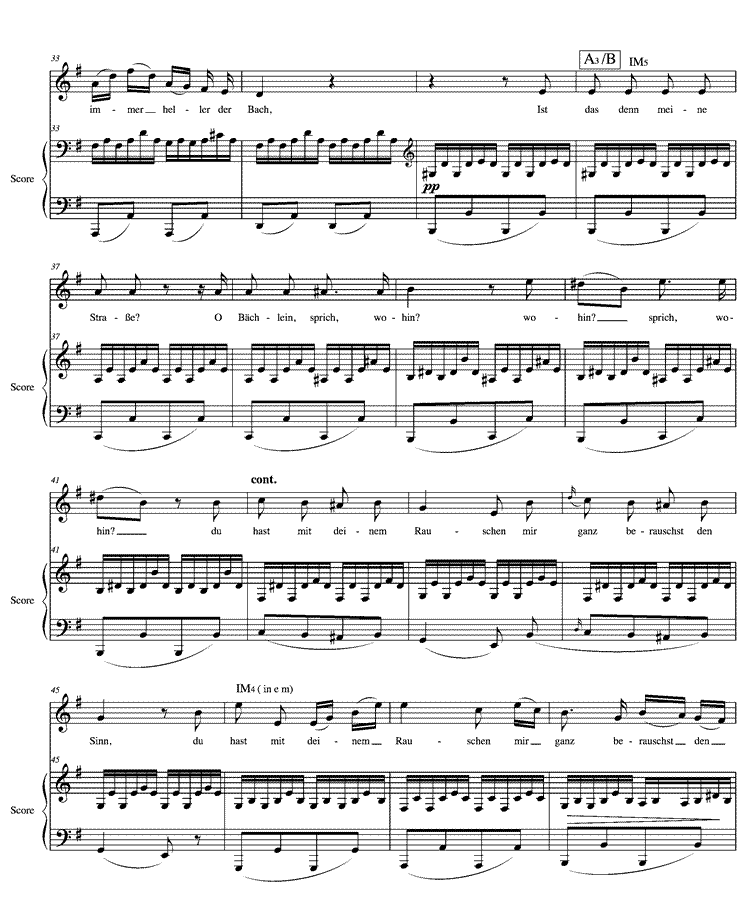
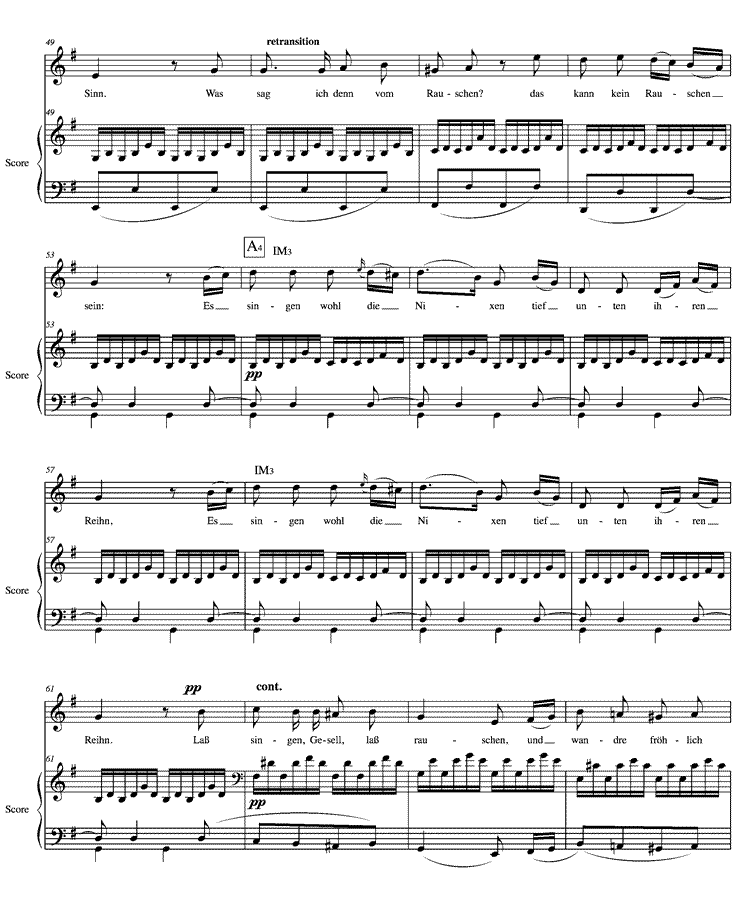
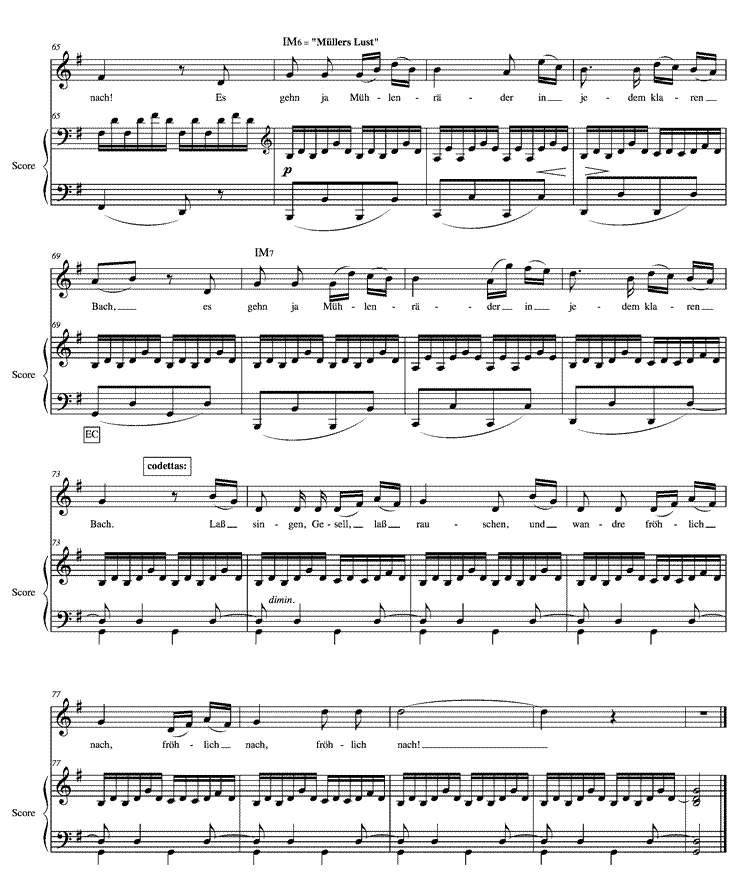
|
Wohin? |
Where to? |
|
Ich hört' ein Bächlein rauschen |
I hear a brook rushing |
Wohin, the second song of the cycle, presents a number of different technical challenges, but for the purposes of this article the authors will limit the discussion to three:
1. Low range. Although much of this song lies in a moderately high tessitura, the melody often dips into the low voice.
2. Repeated notes. The opening of the singer's melody states the note "d" five times.
3. Memorization and confidence. A wide variety of different melodic materials that are recombined makes Wohin difficult to learn, especially in contrast with Das Wandern.
The poetry of this song retains much of the emphatic compulsion to wander of the first song, but gives way to a creeping self-doubt and a questioning of what direction the miller's path should take in the e minor section (A3/B on Table 1). Of course, the music of the entire cycle flip-flops between extroverted self-expression and introverted uncertainty. It is these rapid changes of emotional state that provide the cycle with variety and represent the miller's deepening psychosis. Here, the rapid changes of emotional state are partly reflected in the frequent excursions both below and above the moderately high tessitura of the song. Contrary to the tendencies of the young singer, the low notes should not be pushed since they are intended to be intensely introverted expressions. The highest notes typically accompany an unjustified exuberance (retained from the previous song), a slightly strained carefree attitude that will, simply by function of vocal placement, be reflected in most young voices.
Table 1: Modified Strophic Form in Schubert's "Wohin" (Die Schöne Müllerin)

The piano's musette-like pedal again paints a pastoral scene, although here the sextuplet "rauschen" or rushing of the stream provides the figurative undercurrent for much of the song; the clarity of the "Bächlein's" voice even provides the motivation for the miller to address the stream directly in the e-minor section (A3). The five-fold repeated Ds of the singer's initial melodic idea (IM1 on the score and in Table 1) provide a stark contrast to the disjunction of Das Wandern's opening phrase, yet accomplish essentially the same thing; they act as a hypermetric anacrusis to the arrival on D (the same arrival pitch as in Das Wandern), requiring fine vocal control and a hint of direction toward the downbeat of m. 4. The emphasis of the common-tone D creates a smooth transition between the two first songs, despite their otherwise disparate tonal regions of B♭ and G major. As in the earlier song, the strong-beat arrival on D initiates a melodic discharge with a departure from the syllabic text-setting and a "downward rushing" arpeggiation of the tonic triad (Ich hört' ein Bächlein rau-schen). Drawing this connection may help the singer to imbue the repeated notes with the same energy given to "Müllers Lust" in the opening to Das Wandern.
The recognition of the evolving purpose of the initial melodic idea (IM) may help young singers in their performances, especially since its continual variation is intimately connected to the song's formal outlay. The role of the IM and its many varied manifestations are summarized in Table 2 (below) and shown in relation to the formal design in Table 1.
Table 2: Manifestations, variations, and dramatic purposes of Initial Melodic Idea (IM)
|
IM1 |
mm. 3-10 |
Sudden melodic stasis suggests pause in miller's motion. He is listening to the call of the anthropomorphized stream. Notice, this "corrects" the piano's off-beat fifth pedal (the stream's burbling has perhaps risen to the level of consciousness). |
|
IM2/3 |
mm. 15-22 |
Figure now varied to include motion; the miller feels compelled to follow the stream down into the valley "ich mußte auch hinunter." This is the overlap between the first and second strophes (A1 and A2). |
|
IM4 |
mm. 27-34 |
Now a complete D-major arpeggiation, foreshadowing the D major of the miller maid and statements in song 11, Mein: "Bächlein lass dein Rauschen sein" (brook, stop your rushing) and "Die geliebte Müllerin ist Mein" (the beloved miller maid is mine). The confidence of the miller appears to be confirmed by the "one more time" repetition of the emphatic arpeggiation figure (motivated by an evaded cadence in m. 30). The singer familiar with song 11, however, might point out that the same figure sets statements that are ultimately unheeded; the stream will not stop its rushing and the miller maid will never return the love of the miller. |
|
IM4 |
mm. 36-39 |
Altered to ascend a fourth to the downbeat, appropriately setting the question "ist das denn meine Straße?" (is this, then, my path?). The miller's confidence begins to fade, as a move to e minor in m. 39 underlies an accusation (and terrible foreshadowing): "Du hast mit deinem Rauschen; Mir ganz berauscht den Sinn" (you have intoxicated my senses with your roaring). |
|
IM3 |
mm. 54-61 |
All appears to be well at the beginning of A4. After an explanatory modulation back to G major (mm. 50-52; that can't be roaring, it is just the water-nymphs singing), the second section's modified version of the initial melodic idea returns. |
|
IM6/7 |
mm. 66-73 |
A4 ends with a repetition of IM, now modified to recall "das Wandern ist des Müllers Lust" from the earlier song (m. 66); the miller has, after all, returned to wandering (note the return to the wandering eighth notes in the bass). After an evaded cadence in m. 69, the material is modified again (almost beyond recognition), such that the singer reaches the highest note so far in the cycle (G4)-a moment that seems to suggest overexuberance. |
Generally, the variation of the IM demonstrates a progression away from stasis (the moment of indecision as the miller hears the call of the "Bächlein"). IM5 interrupts with a moment of doubt (and a return to stasis, now in e minor): "ist das denn meine Straße?" (is this, then, my path?), but the song ends with what might be heard as a hyperbolic modification in IM7, which includes the highest note so far in the cycle (G4). This note seems on the verge of spinning out of control, and the young (but talented) singer might consider leaving this note open, resisting the safety of the "covered" tone.6
The miller's changing emotional states and his change in physical direction (down into the stream's valley) requires some sophisticated formal modifications to what is still, at least in essence, a strophic form. This represents a significant challenge to the singer who is expecting a formal design similar to that of Das Wandern. The first and second stanzas of the poem are set as a fairly complete unit (A-A-B-A1-A2) and one might expect the remaining pairs of stanzas to be set in the same manner. It is only at the end of the first section and the onset of the second (mm. 22) that Schubert's setting departs from the simpler scheme of the earlier song. Table 1 summarizes the song's strophic outlay (labeling strophes 1-4 as A1 through A4). Each of the strophes begins and ends with some form of IM, which is typically repeated. Strophes A1 and A2, however, overlap such that mm. 15-22 act both as the end of A1 and the retrospective beginning of A2; a musical enjambment that represents the miller's impatience to continue wandering and to discover his inevitable fate.
A3 is shorter than the other strophes and fulfills the suggestion of earlier tonicizations by modulating to the submediant, e minor. Schubert sets aside the first two lines of the fifth stanza (mm. 50-53), creating a four-bar retransition to an optimistic G major for the final strophe of the song. It is here that the miller attempts to regain his senses by posing a rhetorical question: "but why do I speak of roaring? That can't really be roaring." This moment of self-control prepares a confident return to earlier melodic material in the final section of the song. The singer might consider this as a pivotal point in the song, the last moment to linger before the musical challenges of the ending.
The singer who is aware of these variations on an underlying strophic design will not only be able to learn the song more quickly and accurately, but may also be able to reflect the shifts in character implied therein. The shifting syntactic units require the performers to remain alert; perhaps even surprised by what might happen at any moment. This does, after all, reflect the miller's capriciousness—his ability to change emotions, directions, and goals almost instantaneously. On the other hand, the burden of preserving continuity also falls on the performers, and requires the pianist and vocalist to plan strategically.
Both of these works can certainly be used as exercises for the acquisition of vocal technique, but the authors believe that the in-depth analysis of a song can only strengthen the technical aspects of its performance. If song represents a composer's musical engagement with a poetic text then perhaps the beautiful interpretation of a song requires a commitment to the integrated whole. Indeed, students can be taught to interpret song in a manner that incorporates the technical challenges that they must physically overcome into a larger framework of poetry and music. Even the simple act of asking a student tackling a particular (and seemingly random technical challenge): "Why do you suppose this composer is asking you to do that?" could lead to new and exciting discussions about larger issues of interpretation.
As Eduard Hanslick stated in his treatise On the Musically Beautiful (1854),
In a piece of vocal music, the effectiveness of tones can never be so precisely separated from that of words, action, and ornamentation as to allow strict sorting of the musical from the poetical . . . . Union with poetry extends the power of music.7
We would all agree that extending the "power of music" is a worthwhile goal. Students need to be enticed to approach song from an interpretive standpoint, rather than simply a technical one. In so doing, their "beautiful singing" may be transformed into beautiful music.
List of References
Gibbs, Christopher, ed. The Cambridge Companion to Schubert. New York: Cambridge, 1997.
Hanslick, Eduard. On the Musically Beautiful: A Contribution Towards the Revision of the Aesthetics of Music, Trans. and ed. Geoffrey Payzant. Indianapolis: Hackett, 1986.
La Harpe, Jean François. Journal de Politique et de la Littérature. October 5, 1777.
Lamperti, Giovanni Battista. Vocal Wisdom: Maxims of Giovanni Battista Lamperti: Master of Marcella Sembrich, Stagno, Hastreiter and Other Famous Singers. Enlarged Edition. Recorded and explained by his pupil and assistant William Earl Brown. New York: Arno Press, 1970
.
Marchesi, Mathilde. Marchesi: Vocal Method, op. 31. New York: G. Schirmer, 1900.
Puritz, Elizabeth. The Teaching of Elizabeth Schumann. London: Methuen & Co., 1956.
Endnotes
1Lamperti, Vocal Wisdom, 132.
2Puritz, Teaching of Elizabeth Schumann, 79.
3Marchesi, Vocal Method, Preface.
4Note that Vogl's voice was already considered to be a bit "past its prime" when he first started collaborating with Schubert. See Gibbs, Cambridge Companion to Schubert, 273-74.
5No wonder so many vocalists flee from these classes as soon as the requirements have been completed.
6The "covering" of tones involves a darkening of the sound and a mild modification of vowels. In addition, the focus of the tone is further back in the mouth. The "covering" of high notes can help the student to avoid cracking, but typically at the expense of tone quality.
7Hanslick, Musically Beautiful,15.


